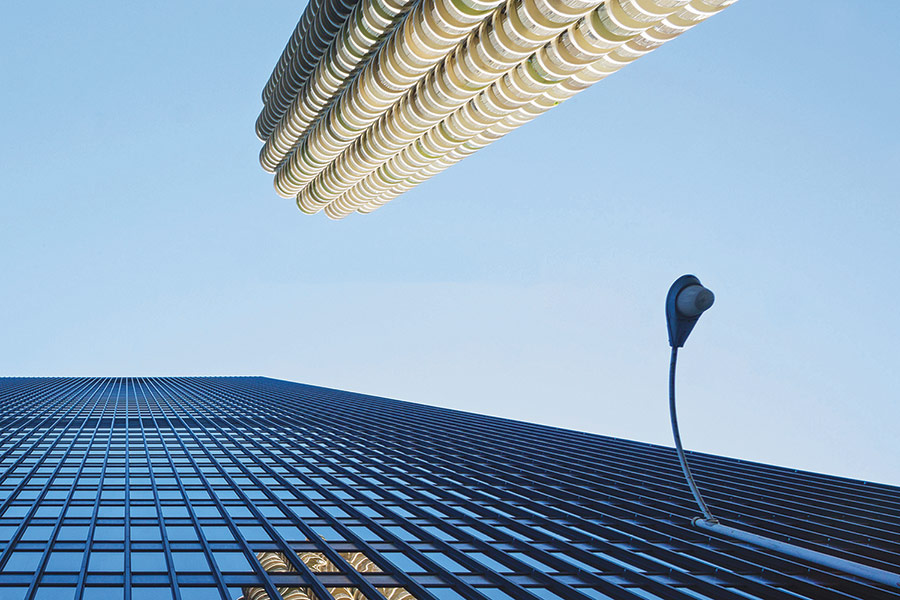
Last is More: Mies, IBM, and the Transformation of Chicago
By Robert Sharoff
Images Publishing Group, $50
The story of Ludwig Mies van der Rohe is the story of Chicago. The two share a narrative of proletariat upbringing, of unmatched ambition, a few lucky breaks and, ultimately, of lasting influence.
Last is More: Mies, IBM, and the Transformation of Chicago illustrates the parallel trajectories of these two giants of the last century through Robert Sharoff’s evocative text and William Zbaren’s crisp, luminous photography. Unlike their previous efforts in the American City series, Sharoff and Zbaren here serve not only as author and photographer, but also as archivists, historians, and interviewers.
The book is split neatly into thirds, perhaps in homage to the historic tripartite elevations that populate Chicago’s streets. The first section is the most thoroughly researched, focusing almost exclusively on Mies, who is shown at the outset gazing up at one of his structures rising out of the cacophony of construction, in front of a backdrop of crumbling brownstones. Like his work, he is elegant, severely modern, in purposeful juxtaposition with his antiquated surroundings.
Using minimal brush strokes, Sharoff draws a vivid profile of Mies, from his early, tepidly received experimentations, through his rise as European academic and leader of the Bauhaus, to his somewhat ambivalent arrival in Chicago and the Illinois Institute of Technology. He spoke limited English, but his ascent to becoming one of the most prominent architectural educators, designers, and thinkers of his generation, or indeed any time, was dazzling.
|
|
||||
Six Mies projects are explored in depth, each succinctly characterized in text and a series of photographs that blend portraiture and abstraction. Zbaren’s images of 860-880 North Lake Shore Drive show the buildings just after dawn, washed in warm sunlight to accentuate the restrained elevation details and bring out the rich travertine texture in the plazas, which Ronald Krueck characterized as “a garden by Mondrian.”
Similarly, the enormous Federal Center superblock could easily read as oppressive, with relentless repetition of mullions and black steel-clad skin. Instead the images explode with life as Zbaren smartly incorporates Alexander Calder’s bright red Flamingo installation into each frame to serve as exuberant counterpoint to the buildings’ subtle articulation.
The IBM building is explored in particular depth. The book features sequential images of the steel structure rising out of the muddy riverfront site, the finished 52-story exterior and the august, exceptionally umber-toned, interior.
Mies did not live to see the completion of the IBM building (he died in 1969 at the age of 83), but the legacy of the structure looms large. Upon its opening in 1972, the Chicago Sun-Times called the building “Twentieth Century architecture at its finest.” It has also proven itself to be a presciently sustainable building. The curtain wall employed double-glazing, the floors were zoned for targeted heating and cooling, and air intake was monitored via a rooftop weather station and regulated by automated dampers.
The section closes with a conversation between Sharoff and Dirk Lohan, a Chicago-based architect and grandson of Mies. Lohan adds a bit of humanity to a picture that could otherwise easily slip into two-dimensional archetype. He discusses the weekly dinners with his grandfather and remembers that Mies never missed an episode of Gunsmoke and only told jokes in German.
The second section of the book supports Ada Louise Huxtable’s claim that “only in Chicago has the Miesian lesson been properly learned,” by exploring the legacy of Miesian architecture and the Second Chicago School. Sharoff and Zbaren illustrate how Mies’ architectural progeny effectively spread the gospel of structural purity, aesthetic refinement, and rational programming across Chicago’s dense downtown district. Mies was so enamored with the muscular structure and expansive column bays of the Richard J. Daley Center that he is purported to have said, “I wish I had done it.”
The final third is a loving look at the architectural context Mies inherited when he moved to Chicago in 1937. Zbaren’s images of the elegant First Chicago School skyscrapers are a mix of intimate detail and broad streetscape context, and highlight the elemental luster of these innovative structures. These pages feature Cobb’s extravagant Chicago Athletic Association, Burnham and Root’s austere Monadnock Building, and Sullivan’s lyrical Carson, Pirie, Scott Building with its vast expanses of glass, decadent cast-iron work, and unyielding terra cotta faces, which make it seem both hazily historic and exceedingly contemporary.
The sequencing of the book is a little disjointed, jumping back to Sullivan and Burnham when all momentum is pushing toward Jahn and Gang. Though the ordering is out of step with the cool dialectic that defines the projects within, and the postscript feels mismatched to the rest of the book, the elegant layout, sumptuous imagery, erudite text, and supporting archival material deftly capture the rarified architectural intent shared by this cadre of designers who helped transform a ramshackle, industrial city into a gleaming, dynamic metropolis.